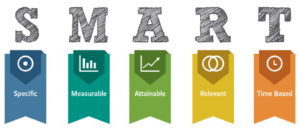Strategic planning is very important for the growth of any business. Management education has advanced strategic planning by incorporating it more and more into the curriculum, thus management graduates can create a plan and devise a strategy as they enter the corporate world. In the previous article Strategic Planning Part 1: Preparation, we focused more on the approach to preparing a business plan. So in Strategic Planning Part 2: Implementation, we will talk about how to make your plan operational by defining action steps and success metrics during the implementation phase. In order to do this, we will focus primarily on SMART goals.

SMART – A Brief Insight
SMART is an acronym which stands for Specific, Measurable, Attainable, Relevant and Time-Based, giving criteria to guide in the setting of objectives. For example, use SMART goals in project management, employee performance management or even personal development. SMART criteria are commonly attributed to Peter Drucker’s management by objectives concept.
SMART goal setting brings structure and trackability into your goals and objectives. Instead of vague resolutions, SMART goal setting creates verifiable trajectories towards a certain objective, with clear milestones and an estimation of the goal’s attainability. Therefore, every goal or objective, from intermediary step to overarching objective, can be made S.M.A.R.T. and as such, brought closer to reality.
SMART goal setting is most effective yet least used tools for achieving goals. Once you’ve charted outlines of your project, it’s time to set specific goals. With the SMART checklist, you can evaluate your objectives. SMART goal setting also creates transparency throughout the company. Additionally, it clarifies the way goals came into existence, and the criteria their realization will conform to. It is one of the best tools to use as a guide to implementing the business strategies formulated in the planning stage and is a valuable resource to measure results.

Define your SMART goals:
Ideally speaking, each business, department, and section should tailor their goals to align themselves with the SMART objectives:
- Specific: target a specific area for improvement.
- Measurable: quantify or at least suggest an indicator of progress.
- Attainable: the goal should be possible to attain, not an impossible one.
- Relevant: state whether the goals are relevant and in sync with the overall business objective.
- Time-bound: specify the time (deadline) when to achieve the result(s).
The S.M.A.R.T. approach is not only valuable in business but can help you achieve personal goals you have set for yourself. Check out this guide for new grads if you are transitioning from college to a career!
Let’s break down each part of S.M.A.R.T. approach to goal-setting and look at examples so you can apply it to implementing your business strategy.
- Specific: Key Questions: Is the goal well-defined? Does it align with overall business objectives in a way that is clear to leadership?
- Measurable: Key Questions: How is success or failure of this goal defined? What are the tactics associated with this goal, and what is the point where a pivot or optimization is needed?
- Attainable: Key Questions: Is this goal even possible? Does the goal understand the audience and interest around the product or initiative?
- Relevant: Key Question: Does this goal fit with overall business objectives in a scalable and manageable way?
- Time-Bound: Key Questions: What is the time frame for this goal? When have other brands in the same space reached similar objectives?
Here’s a SMART Example
A simple example to understand what exactly a SMART goal means. Suppose I set a goal that I want to lose weight. Now, how do I make my goal a SMART one? As it stands now, the goal to simply lose weight does not meet SMART requirements. My goal must be specific (do I want to lose belly fat or overall fat or I want waist reduction?). It must be measurable (how many pounds do I want to lose?). My goal must be attainable (if I weigh 150 pounds my goal cannot be to lose 100 pounds, it would not be realistic).
I must be clear as to why I want to lose weight, whether it is relevant at all (maybe I want to lose weight as my doctor advised me to lose weight to protect myself from certain illness). Make a time-bound goal. (Set a deadline to achieve the desired weight loss). To make this vague goal a SMART goal change it to: “I want to lose 10 pounds and reduce waist by 2 inches by December 31, 2016 (today being September 29) as my doctor suggested me to lose weight to prevent myself from an obesity-related disease. This goal is Specific, Measurable, Attainable, Relevant and Time-Bound.
Once you set up SMART goals, you will have the tools necessary to execute and manage them as well. So plan SMART and get to implementing!
I have sourced my information from:


